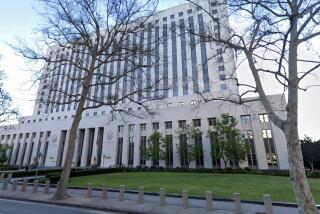Neighbors Fearing Risk of Cancer Oppose 2 DWP Expansion Projects : Environment: Foes cite studies linking high-current power lines to an increased threat to children. The utility says both plans are needed to meet demand.
A controversy over potential cancer risks from electromagnetic fields is stirring opposition in the San Fernando Valley to two proposals to expand the city’s electrical transmission and distribution systems.
In Arleta, angry residents are signing petitions against a plan by the Los Angeles Department of Water and Power to build a new electric distributing station along the 13200 block of Branford Street. A few miles west, some neighbors are criticizing plans to install a third transmission tower and two more high-voltage power lines on an existing transmission line corridor linking Granada Hills and Northridge.
DWP officials say both projects are needed to meet growing electric demand.
But opponents say the projects may be dangerous, citing studies that show a small increase in the risk of cancer risk among children living near high-current power lines. A variety of studies have also found higher rates of cancer among workers in electrical occupations, such as utility linemen, electricians and power station operators.
Other research has found no cancer link, and it remains uncertain if there is any hazard from electric and magnetic fields. The EM fields are invisible lines of force that radiate outward from every wire and device that carries electric current, dropping off sharply with distance from the source.
In a draft report earlier this month, the U.S. Environmental Protection Agency described EM fields “from power lines and perhaps other sources in the home as a possible, but not proven, cause of cancer in humans.” Despite the ambiguous conclusion, there were delays in releasing the report due to White House concern that it would panic the public.
Concern already has run high in communities across the country. In the San Fernando Valley, residents in two neighborhoods accuse the DWP of irresponsibility for pushing ahead with expansion plans while the controversy rages.
For their part, DWP officials contend that even if EM fields pose a risk, the two proposed projects will not increase human exposures to the fields.
The Arleta project has brought turmoil to a neighborhood of modest, single-family houses, where at least two families close to the station site vow to move away if it is built.
“I’m happy with the area and I can’t even afford to move anywhere else,” said George Heidlberg, who has lived for a dozen years across from the proposed Branford Street site. But he said there is no way he would stay if the project is built. “I just don’t want to take chances with the life of my little girl.”
Karen Zuccolillo, whose home is separated from the proposed station by the width of the Tujunga Wash said she feels “it’s dangerous, yes, but can I prove it? No. No more than they can prove that it’s not . . . . For that reason alone, I think they ought to put it somewhere else.”
Zuccolillo, who has three children, said she “wouldn’t feel safe staying here” if the station is built. “If in 20 years they decide these . . . power facilities do cause cancer or other health effects, what do I do then?”
Opponents are seething most over the DWP’s decision to forgo a detailed environmental study on the project and instead issue a “negative declaration,” a statement that the project has no potentially significant environmental effects.
Given concerns about EM fields, a negative declaration is “totally off the wall,” said Joe Bonilla, an Arleta resident and treasurer of the Arleta Chamber of Commerce and Residents Assn., which is spearheading opposition to the project. It appears department officials have “been in hiding for years and just stepped out of a time warp,” Bonilla said.
A distributing station transforms high-voltage current into lower-voltage power for distribution to nearby houses and businesses. The DWP operates about 130 distributing stations citywide, many of them surrounded by masonry walls that are architecturally treated to look like Mediterranean or Spanish-style buildings.
DWP officials say the new station is needed to avoid overloading four other East Valley distributing stations that now serve the Arleta and Pacoima areas. The department has purchased options on two adjacent houses on Branford Street that would be razed to make room for the $9-million facility. Plans call for construction to start late next year and the station to be in service by March, 1993.
The controversy actually began as a zoning battle, with residents worried the station would be a foot in the door for commercial development in their neighborhood of small, single-family houses. The DWP needs a conditional use permit from the city Planning Commission to build the station.
Merging health and zoning concerns, opponents have urged the DWP to build the station on property the department already owns at Sheldon Street and Arleta Avenue, about a half-mile away.
DWP officials say the station would cost more and be less effective if built at that site, due to power losses from running distribution lines a longer distance to the service area.
As for the negative declaration, DWP officials contend that the distributing station will not increase the strength of EM fields in nearby yards and houses. Thus, they say, it will have no environmental impact.
However, they acknowledged in interviews that the conclusion was based on limited measurements at a few distributing stations.
Those measurements, they said, showed magnetic fields at the outer wall of distributing stations ranging from less than 2 milligauss to 9.5 milligauss. A milligauss is a unit of measure of magnetic field strength.
By comparison, a typical househas a magnetic field of up to 1 milligauss, with higher readings near operating appliances. In one study, an increased risk of childhood cancer was associated with field strengths in the home of about 2 to 3 milligauss. Field strengths fall dramatically with distance, prompting the DWP to conclude that people near the distributing station would not be exposed to elevated fields.
DWP officials said they are taking more measurements at distributing stations and will present the data at a public meeting in Arleta late in January.
“I would not want the general public to perceive that there’s no sensitivity to their concerns,” said Bernard V. Palk, the DWP’s assistant chief engineer for power.
He said the “public perception” of a health risk will be considered by the Board of Water and Power Commissioners, which oversees department operations. The board--recently stocked with environmentally minded commissioners in a shake-up ordered by Mayor Tom Bradley--is expected to decide early next year whether to approve the negative declaration.
“If they believe it will need to be addressed in a full-blown environmental impact report,” an EIR will be ordered, Palk said.
A draft EIR has already been issued on the proposed Rinaldi-Northridge transmission line project, extending 6.7 miles from an electrical receiving station at 15901 Rinaldi St. in Granada Hills to a second receiving station at 18821 Parthenia St. in Northridge.
The existing right of way, 220 feet wide in most places, contains two transmission towers, each supporting two 230-kilovolt transmission lines.
The $14.5-million expansion would involve erecting a third tower between the other two to carry two more 230-kV lines.
If commissioners approved the project, plans call for construction to start in September, 1992, and take nine months. DWP officials said one of the two new lines will be needed by 1993 and the other by 1998, but that both might be installed at once.
Power lines can be “phased”, or arrayed in such a way that magnetic fields from parallel lines tend to cancel one another. Department officials said they plan to array the new lines so that field strengths at the edge of the right of way will be slightly lower than they are now.
“We can build it this way, and the fields will go down slightly,” said Mike Reavis, a supervising engineer with DWP. “What effect that has on health we can’t say,” said Reavis. Opponents of the project are skeptical. “I cannot see how adding one-third the power can be a health benefit to me,” said Roger S. Waldbaum, who lives in a townhouse in the shadow of the transmission lines near the intersection of Devonshire Street and Lindley Avenue. “It flies in the face of reality.”
“I remember ‘way back when the cigarette companies claimed that smoking was good for you,” Waldbaum said. “It was only 30 years later that independent research proved that smoking caused cancer--much too late to help all those who died.”
Related story: A1
More to Read
Sign up for Essential California
The most important California stories and recommendations in your inbox every morning.
You may occasionally receive promotional content from the Los Angeles Times.






